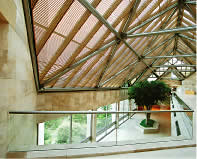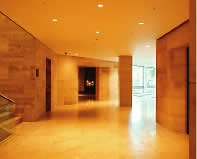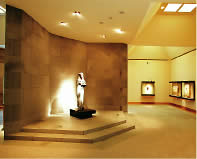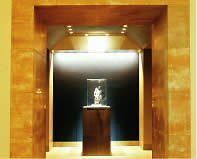 |
 |
Passing through a grove of peach blossoms in full bloom and
through a cave, you arrive upon the village of the Peach Blossom Spring.
What would you do if you were to create such a place? |
| When you walk into the exhibition galleries and halls of MIHO MUSEUM, you will notice that the spaces all form into six-sided tortoise-shell shapes. Look up the stairway of the entrance from the walls near the Dionysus mosaic and find a variety of large and small, long and short hexagons hidden here and there. It almost makes you want to play a game of finding six-sided spaces with children. |
 If you carefully look at the first hall and stairwell near the entrance, you will find combinations of hexagons. Even the large planters of the ficus benjamins, the concavity of the Museum Shop, and the projection of the facing gallery are hexagonal. The floor plan of the museum also shows that the Egypt and West Asian galleries as well as the special exhibition rooms all form hexagons. This elaborate combination of six-sided patterns is ingenious. Its soft undulating curves draw our eyes from one space to another. For example, when leaving the Pine View Cafe, the entrance to the West Asian gallery and the hallway opening to the right subtly attracts our attention. The curved walls of the galleries facing the hallway create an interesting transition welcoming us to the gallery entrances. A set of stairs, inclined to the left, at the end of the hall, invites us up to the upper level. Like flowing water, we are drawn forward in all directions. When we enter a hexagonal gallery, the space opens up magnanimously, and as we walk around the gallery, the room appears to expand at each turn. If you carefully look at the first hall and stairwell near the entrance, you will find combinations of hexagons. Even the large planters of the ficus benjamins, the concavity of the Museum Shop, and the projection of the facing gallery are hexagonal. The floor plan of the museum also shows that the Egypt and West Asian galleries as well as the special exhibition rooms all form hexagons. This elaborate combination of six-sided patterns is ingenious. Its soft undulating curves draw our eyes from one space to another. For example, when leaving the Pine View Cafe, the entrance to the West Asian gallery and the hallway opening to the right subtly attracts our attention. The curved walls of the galleries facing the hallway create an interesting transition welcoming us to the gallery entrances. A set of stairs, inclined to the left, at the end of the hall, invites us up to the upper level. Like flowing water, we are drawn forward in all directions. When we enter a hexagonal gallery, the space opens up magnanimously, and as we walk around the gallery, the room appears to expand at each turn.
 Inside the Egyptian gallery is an inner room composed of right angles. This is the chamber of the Falcon-headed Deity. To enter this space, surrounded by thick slabs of limestone, one has to turn ninety degrees, which creates the solemn effect similar to going through a narrow stone passage. Some three thousand years ago, the Falcon-headed Deity may have been kept in the innermost chamber of a shrine, to which only a few priests had access to pray to this god. It is a space that should be entered great solemnity. Inside the Egyptian gallery is an inner room composed of right angles. This is the chamber of the Falcon-headed Deity. To enter this space, surrounded by thick slabs of limestone, one has to turn ninety degrees, which creates the solemn effect similar to going through a narrow stone passage. Some three thousand years ago, the Falcon-headed Deity may have been kept in the innermost chamber of a shrine, to which only a few priests had access to pray to this god. It is a space that should be entered great solemnity.
 In this way, through all the different spatial transformations of each room, one comes to appreciate the versatile design of the hexagon, which fills the spaces with various suggestive nuances. Within the compositions and patterns that draw our eyes to the left and right, we can almost hear the voice of the designer. In this way, through all the different spatial transformations of each room, one comes to appreciate the versatile design of the hexagon, which fills the spaces with various suggestive nuances. Within the compositions and patterns that draw our eyes to the left and right, we can almost hear the voice of the designer. |

Entrance

Leaving the Pine View Café

Egyptian Gallery

Falcon-headed Deity
|
|




